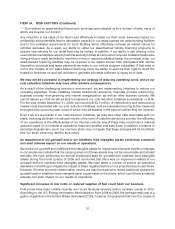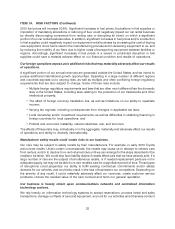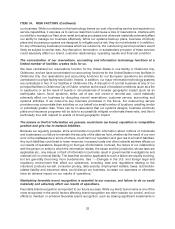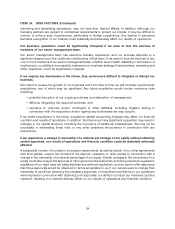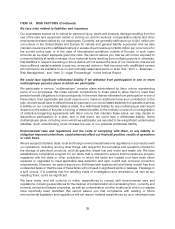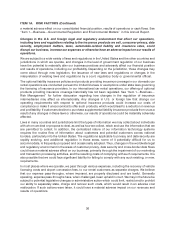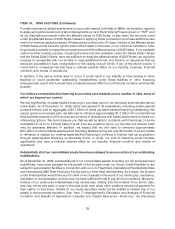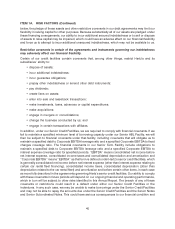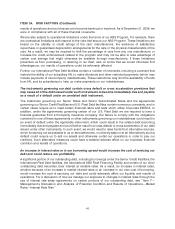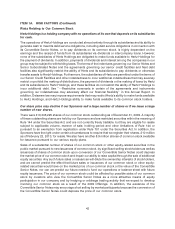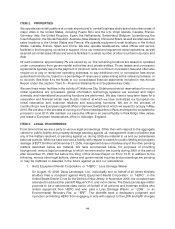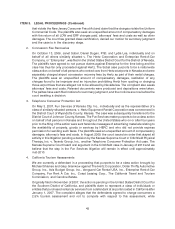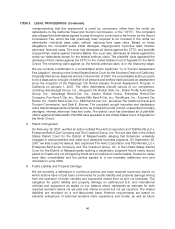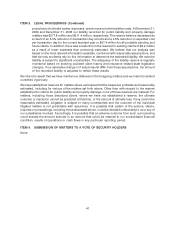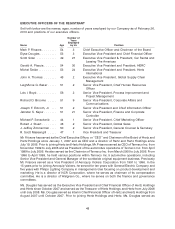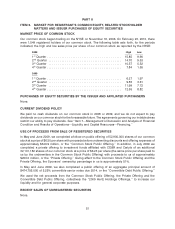Hertz 2009 Annual Report Download - page 61
Download and view the complete annual report
Please find page 61 of the 2009 Hertz annual report below. You can navigate through the pages in the report by either clicking on the pages listed below, or by using the keyword search tool below to find specific information within the annual report.ITEM 1A. RISK FACTORS (Continued)
results of operations and could cause us to become bankrupt or insolvent. As of December 31, 2009, we
were in compliance with all of these financial covenants.
We are also subject to operational limitations under the terms of our ABS Program. For example, there
are contractual limitations with respect to the cars that secure our ABS Program. These limitations are
based on the identity or credit ratings of the cars’ manufacturers, the existence of satisfactory
repurchase or guaranteed depreciation arrangements for the cars or the physical characteristics of the
cars. As a result, we may be required to limit the percentage of cars from any one manufacturer or
increase the credit enhancement related to the program and may not be able to take advantage of
certain cost savings that might otherwise be available through manufacturers. If these limitations
prevented us from purchasing, or retaining in our fleet, cars on terms that we would otherwise find
advantageous, our results of operations could be adversely affected.
Further, our International Fleet Debt facilities contain a number of covenants, including a covenant that
restricts the ability of our subsidiary HIL to make dividends and other restricted payments (which may
include payments of intercompany indebtedness). These restrictions may limit the availability of funds
from HIL and its subsidiaries to help us make payments on our indebtedness.
The instruments governing our debt contain cross default or cross acceleration provisions that
may cause all of the debt issued under such instruments to become immediately due and payable
as a result of a default under an unrelated debt instrument.
The indentures governing our Senior Notes and Senior Subordinated Notes and the agreements
governing our Senior Credit Facilities and U.S. Fleet Debt facilities contain numerous covenants, and in
certain cases require us to meet certain financial ratios and tests which utilize Corporate EBITDA. In
addition, under the agreements governing certain of our U.S. Fleet Debt we are required to have a
financial guarantee from a third-party insurance company. Our failure to comply with the obligations
contained in one of these agreements or other instruments governing our indebtedness could result in
an event of default under the applicable instrument, which could result in the related debt becoming
immediately due and payable and could further result in a cross default or cross acceleration of our debt
issued under other instruments. In such event, we would need to raise funds from alternative sources,
which funds may not be available to us on favorable terms, on a timely basis or at all. Alternatively, such a
default could require us to sell our assets and otherwise curtail our operations in order to pay our
creditors. Such alternative measures could have a material adverse effect on our business, financial
condition and results of operations.
An increase in interest rates or in our borrowing spread would increase the cost of servicing our
debt and could reduce our profitability.
A significant portion of our outstanding debt, including borrowings under the Senior Credit Facilities, the
International Fleet Debt facilities, the International ABS Fleet Financing Facility and certain of our other
outstanding debt securities, bear interest at variable rates. As a result, an increase in interest rates,
whether because of an increase in market interest rates or an increase in our own cost of borrowing,
would increase the cost of servicing our debt and could adversely affect our liquidity and results of
operations. For a discussion of how we manage our exposure to changes in interest rates through the
use of interest rate swap agreements on certain portions of our outstanding debt, see ‘‘Item 7—
Management’s Discussion and Analysis of Financial Condition and Results of Operations—Market
Risks—Interest Rate Risk.’’
41


